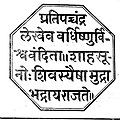
Back شاهترباتي Arabic ছত্রপতি Bengali/Bangla Čhatrapatí Czech Chhatrapati German Chhatrapati French छत्रपति Hindi Chhatrapati ID Chhatrapati Italian チャトラパティ Japanese 차트라파티 Korean
| Chatrapati of the Marathas | |
|---|---|
| Marāṭhyānche Chatrapatī | |
Federal | |
Seal | |
| Details | |
| Style | His Majesty |
| First monarch | Shivaji I |
| Last monarch | Pratap Singh |
| Formation | 1674 |
| Abolition | 1818 |
| Residence |
|
Chhatrapati is a royal title from Sanskrit used to denote a king. The word "Chhatrapati" is a Sanskrit language compound word of chhatra (parasol or umbrella) and pati (master/lord/ruler).[1] This title was used by the House of Bhonsle, between 1674 and 1818, as the heads of state of the Maratha Confederacy.
The states of Satara and Kolhapur came into being in 1707, because of the succession dispute over the royalty. Shahuji, the heir apparent to the Maratha empire, captured by the Mughals at the age of nine, remained their prisoner at the death of his father Sambhaji, the elder son of Shivaji the founder of the Maratha Empire, in 1689. The dowager Maharani Tarabai (wife of Rajaram I) proclaimed her son Shivaji II, as Chhatrapati under her regency. The Mughals released Shahu under certain conditions in 1707, and he returned to claim his inheritance. He defeated the regent at the Battle of Khed and established himself at Satara, forcing her to retire with her son to Kolhapur. By 1710 two separate principalities had become an established fact. Shivaji II and Tarabai were soon deposed by the other wife of Rajaram, Rajasbai. She installed her own son, Sambhaji II, as the new ruler of Kolhapur. Sambhaji II signed the Treaty of Warana in 1731 with his cousin Shahuji to formalize the two separate seats of Bhonsle family.[2]
- ^ Fairey, Jack; Farrell, Brian P. (2018-06-28). Empire in Asia: A New Global History: From Chinggisid to Qing. Bloomsbury Publishing. ISBN 978-1-4725-9123-4.
- ^ Sailendra, Sen (2013-01-01). Textbook of medieval Indian history. Primus Books. ISBN 9789380607344. OCLC 822894456.
© MMXXIII Rich X Search. We shall prevail. All rights reserved. Rich X Search

